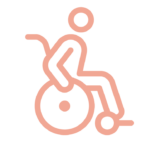Spasticity in MS (Multiple Sclerosis)

Spasm and stiffness in multiple sclerosis
When multiple sclerosis affects motor areas of the central nervous system, it can impact connections between the brain and muscles, causing muscles to feel rigid or stiff or to spasm and jerk involuntarily.
Muscle tightness and jerking are common among people living with multiple sclerosis, with symptoms ranging from mild to severe. Some mild muscle stiffness can actually be beneficial for people with leg weakness, making it easier to stand and walk, but it still needs to be managed. If these symptoms sound familiar to you, read on to learn more about how they can impact people living with multiple sclerosis and how they are managed and treated.
2.8M
people
worldwide live with multiple sclerosis1
86%
of people
with multiple sclerosis have some form of spasticity2
85%
of people
with multiple sclerosis present with the relapsing-remitting form3

Measuring spasticity
The impact of spasticity can be measured using the Ashworth Scale, which can be used to:

Assess resistance to passive stretching

Measure muscle tone using a five-point scale (six in the modified version)

Assess the impact on a person’s ability to move around and their independence

Differentiate between mild and severe spasticity
What is multiple sclerosis?
Multiple sclerosis (MS) is believed to be an autoimmune disease, caused by the immune system attacking healthy tissue in the central nervous system (the brain, spinal cord, and optic nerves). When the insulating layer that protects nerve fibers (called myelin) is damaged, it can lead to inflammation that blocks the passage of nerve signals and causes messages from the brain to be slowed or lost. This, in turn triggers the symptoms of multiple sclerosis, including cognitive difficulties, vision problems, movement difficulties, fatigue, muscle weakness and tightness, and spasms.
There are four types of multiple sclerosis, classified by disease activity and progression:
- Clinically isolated syndrome (CIS)
- Relapsing-remitting multiple sclerosis (RRMS)
- Secondary-progressive multiple sclerosis (SPMS)
- Primary-progressive multiple sclerosis (PPMS).4
In relapsing-remitting multiple sclerosis, symptoms suddenly come and go, or worsen, during periods of relapse (also known as flare-ups or exacerbations), which can last for a few days, weeks, or months. In the progressive forms of the disease, symptoms gradually worsen over time.

Recognizing spasticity in multiple sclerosis
While spasticity in multiple sclerosis can go unnoticed, it´s important to recognize the signs and symptoms to be able to manage and treat the condition effectively.
Is it spasticity?
Feelings of inflexible or tight muscles, as well as problems with jerking and kicking movements in multiple sclerosis, are all symptoms of a condition known as spasticity. Spasticity looks and feels different for everyone, but there are some common symptoms to watch out for.
Various signs to look for
- Muscles that feel stiff, tight, rigid, numb, heavy, or paralyzed
It can be difficult to bend or straighten your arms, legs, fingers, or other parts of the body - Spasms
Involuntary jerking or kicking movements, or uncontrolled bouncing, tremors, twitches, or shakes - Muscle twitching and jerking
Getting worse at night, interrupting sleep - Pain or tightness around the joints
As well as lower back pain - Movement difficulties
Making it difficult to walk, balance, or stand up straight
What can trigger spasticity in multiple sclerosis?
Like other symptoms of multiple sclerosis, muscle rigidness and spasms can flare up during a period of relapse. Different trigger factors (including changes in your environment or routine) can worsen or exacerbate problems with muscle tightness and jerking, so it’s useful to try and identify these trigger factors to effectively manage symptoms and minimize their effects. Triggers are different for each person, so you’ll need to work with your healthcare team to track your symptoms and identify possible triggers for you. Triggers could include:
- Other multiple sclerosis symptoms, such as bowel or bladder dysfunction
- Sudden movements, position changes, or lack of movement
- Fatigue or time of day, often at night
- Temperature changes
- Infections or injuries
- Tight clothing
- Skin irritation or pressure sores
- Emotional stress
Spasticity treatment and exercises for people with multiple sclerosis
Left untreated, muscle stiffness can cause contractures (frozen joints) and pressure sores. Both muscle tightness and spasms can be treated through exercises – stretching, range-of-motion, and relaxation – along with physical therapy, hydrotherapy, massage, and orthoses.
Medical interventions such as botulinum neurotoxin can also help. Your multidisciplinary specialist team will work with you to develop a personalized treatment and exercise plan to manage your symptoms and trigger factors.




References
1. Walton C, King R, Rechtman L, et al. Rising prevalence of multiple sclerosis worldwide: Insights from the Atlas of MS, third edition. Mult Scler. 2020 Dec;26(14):1816-1821.
2. 2. Milinis K, Tennant A, Young CA; TONiC study group. Spasticity in multiple sclerosis: Associations with impairments and overall quality of life. Mult Scler Relat Disord. 2016 Jan;5:34-9.
3. McKay KA, Kwan V, Duggan T, Tremlett H. Risk factors associated with the onset of relapsing-remitting and primary progressive multiple sclerosis: a systematic review. Biomed Res Int. 2015 Jan; 2015:817238.
4. Lublin FD, Reingold SC, Cohen JA, et al. Defining the clinical course of multiple sclerosis: the 2013 revisions. Neurology. 2014 Jul;83(3):278-286.


